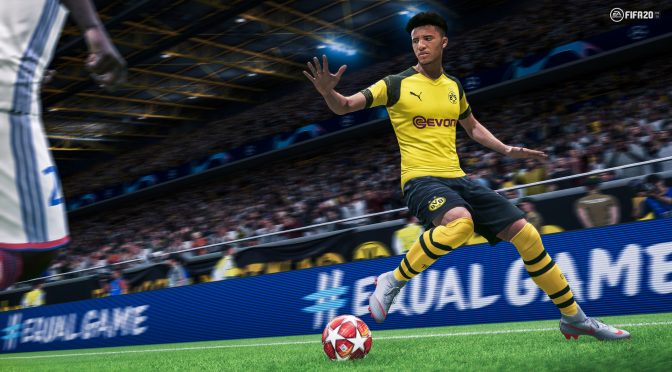EA Sports has released a brand new official gameplay trailer for FIFA 20, showcasing some of its gameplay features. The game will feature a new Penalty Kick system, an improved free kick system, a brand new dynamic 1vs1 system, new ball physics and composed finishing.
FIFA 20 will be, once again, powered by the Frostbite Engine and is currently scheduled for a September 27th release. It’s also worth noting that the game will introduce a new game mode called VOLTA.
VOLTA Football takes the game back to the streets with the authentic culture, creativity and style of the small-sided game played on streets, courts and futsal pitches around the globe. Basically, think of VOLTA as a an enhanced version of FIFA Street.
Here are the key features of FIFA 20:
Authentic Game Flow
Authentic Game Flow gives AI-controlled players an increased understanding of time, space, and position on the pitch, placing more emphasis on user-controlled play through new Dynamic One-on-Ones, enhanced AI Defending, and Natural Player Motion.
- Dynamic One-on-Ones: built using the game tempo from the world’s best leagues, an overhauled gameflow offers more true-to-life spacing and pace of play, resulting in more 1 on 1 opportunities putting emphasis on user-controlled Decisive Moments.
- AI Defending: an overhaul in the positioning and tackling system creates an environment for AI to better complement the user-controlled player. AI will offer intelligent defensive support, while rewarding and advantaging user defending.
- Natural Player Motion: with locomotion and positioning innovations AI players move in a more natural and composed fashion than ever before, creating realistic football movement for all players on the pitch.
Decisive Moments
Decisive Moments give you more control over the moments that determine the outcome of a match. From Composed Finishing in the final third to Controlled Tackling at the back, along with new Strafe Dribbling and a Set Piece Refresh, you’ll have increased input in the key stages of each game.
- Strafe Dribbling: the new strafe dribble mechanic adds more dimension to attacking options; enabling you to move with more agility than ever to lure your opponent in before beating him with speed or skill.
- Controlled Tackling: Using the Active Touch System, user-controlled defending is advantaged and rewarded through a variety of new tackle animations. The cleaner the tackle, the higher the likelihood of retaining possession of the ball.
- Set Piece Refresh: A system refresh gives deeper options for aiming direct free kicks and penalties and introduces more skill-based mechanics for ball-striking that are more rewarding than ever.
- Composed Finishing: An overhaul in the fundamentals of shooting will give you more consistent and clinical finishing, creating a more true-to-life shooting experience that better rewards authentic finishing and offers risk and reward in more difficult situations like volleyed crosses.
Ball Physics
The new Ball Physics System elevates gameplay in FIFA 20 to a new level of realism, offering new shot trajectories, more realistic tackle interactions, and physics-driven behaviour.
- Football Informed Motion: an overhauled motion system introduces more authentic ball spins and bounces that play out with more realism than ever before, creating a more true-to-life football experience.
- New Shot Trajectories: with the new ball motion system a variety of realistic shot trajectories are unlocked, from technically dipping shots to knuckleballs, to swerved set-pieces and first-time rising shots.
Enjoy!

John is the founder and Editor in Chief at DSOGaming. He is a PC gaming fan and highly supports the modding and indie communities. Before creating DSOGaming, John worked on numerous gaming websites. While he is a die-hard PC gamer, his gaming roots can be found on consoles. John loved – and still does – the 16-bit consoles, and considers SNES to be one of the best consoles. Still, the PC platform won him over consoles. That was mainly due to 3DFX and its iconic dedicated 3D accelerator graphics card, Voodoo 2. John has also written a higher degree thesis on the “The Evolution of PC graphics cards.”
Contact: Email

